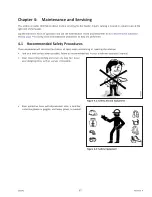
262391
64
Revision A
Table 3.6 Recommended Windrow Characteristics
Characteristic
Advantage
High and fluffy
Enables airflow through the windrow, which is more important to the curing
process than direct sunlight
Consistent formation (not bunching)
Permits an even flow of material into the baler, chopper, etc.
Even distribution of material
across windrow
Results in even and consistent bales to minimize handling and
stacking problems
Properly conditioned
Prevents excessive leaf damage
3.15.5
Driving on Windrow
Driving on previously cut windrows that will not be raked can lengthen the drying time by a full day. If practical, set the
machine
’
s forming shields to produce a narrower windrow which the machine can straddle. However, driving on the
windrow in high-yield crops may be unavoidable if a full width windrow is necessary.
3.15.6
Raking and Tedding
Raking or tedding speeds up the drying process; however, the resulting leaf loss may outweigh the benefits. There is little
or no advantage to raking or tedding if the ground beneath the windrow is dry.
Large windrows on damp or wet ground should be turned over when the moisture levels reach 40
–
50%. Hay should not be
raked or tedded at moisture levels below 25% or excessive yield loss will result.
3.15.7
Using Chemical Drying Agents
Hay drying agents work by removing wax from legume surfaces, allowing moisture to escape from cut crop and evaporate
faster. However, treated hay lying on wet ground will absorb ground moisture faster, even if a hay drying agent is used.
Before deciding to use a drying agent, carefully compare the costs and benefits of doing so.
















































